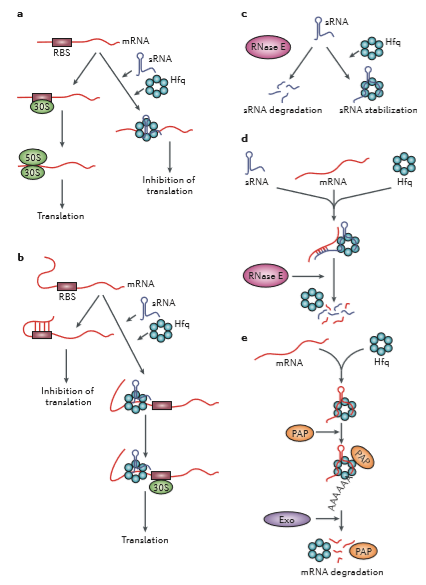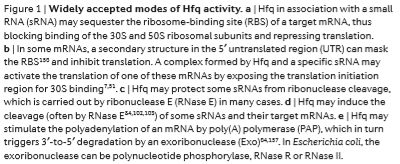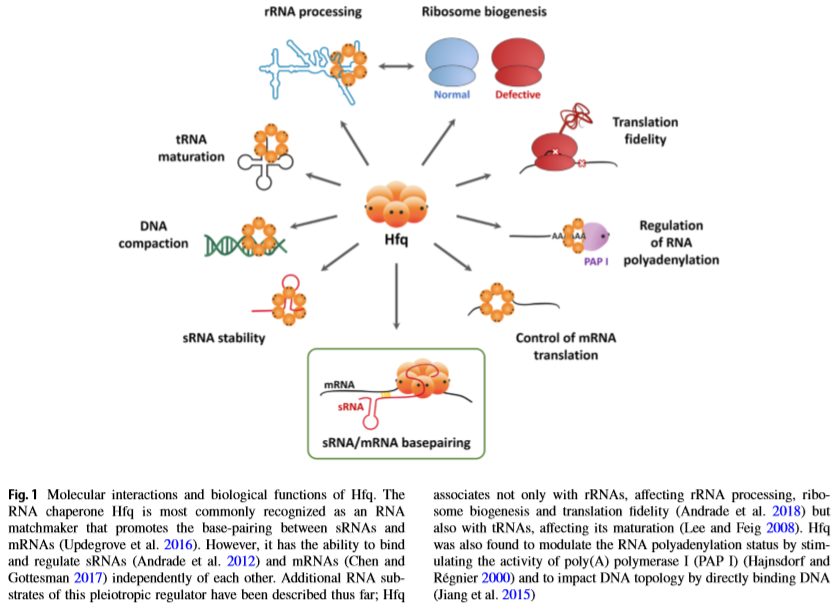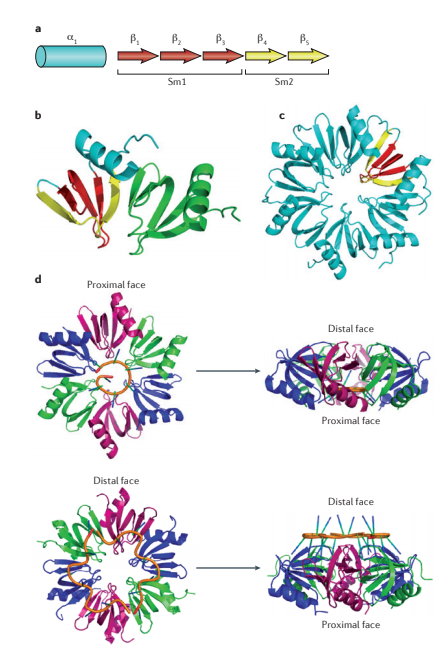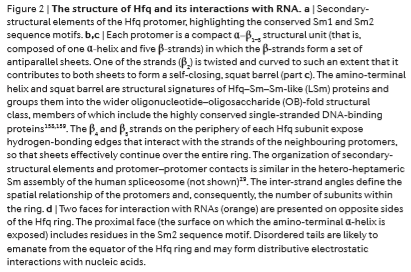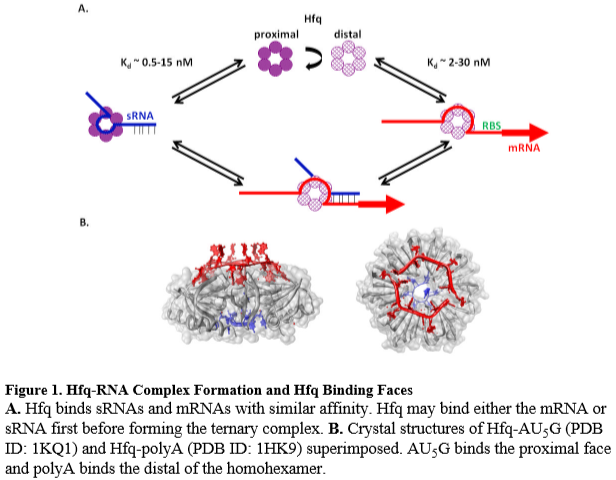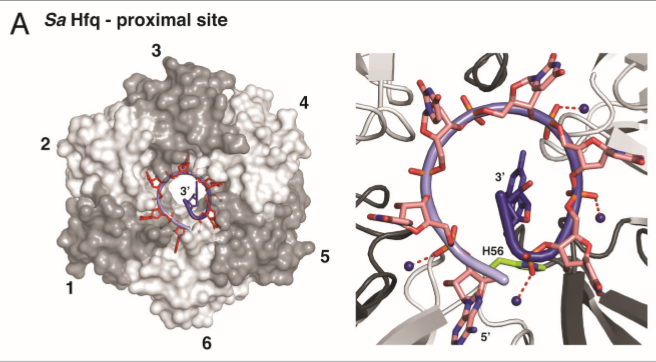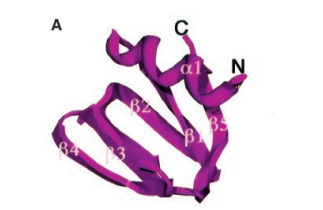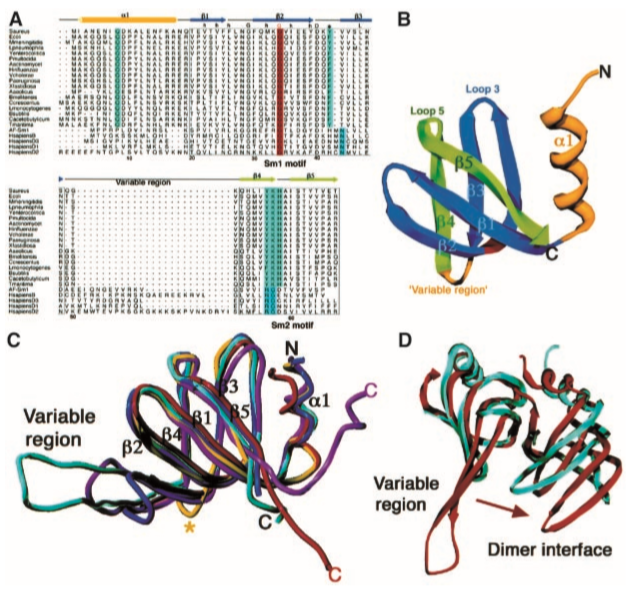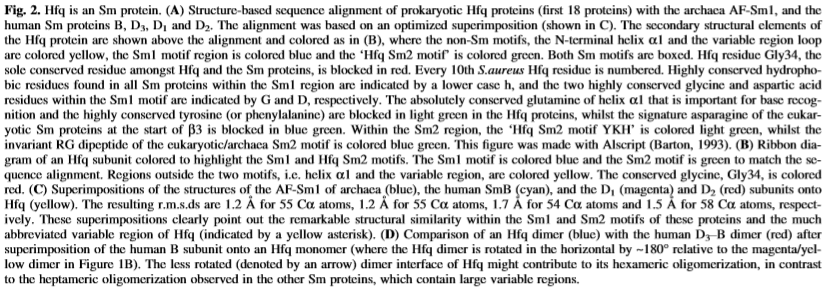Sandbox 1
From Proteopedia
|
Contents |
History
Hfq was first identified in the lates 1960s in Escherichia coli as an essential host factor for the RNA replication of the bacteriophage Qβ. Later, in the 1990s, was shown that Hfq could provide greatest benefits to the bacterium itself, rather than to its phage predator. Tsui and colleagues, in 1994, described a diverse of pleiotropic effects caused by the disruption of the hfq gene, related to fitness reduce, stress response impairment and, in pathogenic bacterias, diminishment of virulence (Vogel & Luisi, 2011).
Function
Hfq is a bacterial post-transcriptional regulator that modulates RNA structure, acting as a RNA chaperone. The most well-characterized function of Hfq is its role as a RNA matchmaker, promoting interactions between trans-encoded sRNAs (small regulatory RNAs) and their messenger RNAs (mRNAs) targets, leading translation and RNA stability regulation (dos Santos et al., 2019). In Bacteria sRNAs are critical for bacterial survival under adverse conditions and expression of virulence factors. Trans-encoded sRNAs are a large class of this regulators that are transcribed from a different locus than their targets and act as a imperfect base pairing, often regulating multiple mRNA (Faner & Feig, 2014). The resulting network of regulation of Hfq-RNA are best characterized in Escherichia coli and Salmonella typhimurium, but it importance is recognized in a diverse population of bacteria (Faner & Feig, 2014). Basically, Hfq plays a active role in positioning RNAs for optimal base pairing by changing the secondary or tertiary structures of RNAs, bringing RNAs into proximity, neutralizing the negative charge of the two pairing RNAs, stimulating the nucleation of the first base pairs as well as facilitating the further annealing of the two RNA strands (Updegrove et al., 2016). There are several mechanisms to Hfq-mediated regulation. Most of the Hfq/RNAs/RNAm interactions described report inhibition of translation, although there are cases of positive regulation (dos Santos et al., 2019). Hfq can suppress protein synthesis by aiding the sRNA to bind the 5’ region of its target mRNA turning this region inaccessible to translation initiation. In the other way, this RNA chaperone can also act boosting translation, where sRNA guided by Hfq can bind in the 5’ region of the mRNA, changing its structure that otherwise inhibits ribosome binding. Hfq can also present a sRNA to its mRNA target leading to both degradation (Vogel & Luisi, 2011). It also has been shown that Hfq can interacts with either RNAs or RNAm independently, not just between this molecules. Hfq can modulate mRNA stability by directly binding and remodeling without the sRNA. It can also promotes the polyadenylation at the 3’ end of mRNAs, which in turn triggers 3’ to 5’ degradation by a exoribonuclease. The Hfq association also protects sRNAs from degradative activity of polynucleotide phosphorylase (PNPase) and ribonuclease E (RNase E) (Vogel & Luisi, 2011; dos Santos et al., 2019). Hfq is able to bind ATP, however, the chaperoning activity does not require ATP hydrolysis (dos Santos et al., 2019).
Recently, the discovery of others binding substrates with Hfq has expanded the regulatory spectrum of this protein. It was found that this RNA chaperone can also bind with rRNA and tRNA. Studies have shown that Hfq promotes ribosome assembly in bacteria, where this protein is required for the processing of pre-16S and folding of the mature 16S rRNA in E. coli, displaying Hfq as a important ribosome biogenesis factor in bacterias. This process seems to be independent of Hfq interactions with sRNAs, which the binding surfaces of the vast majority of the Hfq-dependent sRNAs are the proximal and rim faces, and for the rRNA, in the distal face of the Hfq. The same was observed for tRNA, where Hfq was also associated as a important pre-tRNA maturation factor, however, the binding of the structural elements of tRNAs occurs through the proximal face of Hfq (dos Santos et al., 2019). Notably, the regulatory activity of Hfq is not restricted to RNAs, it was also found to bind DNA and protein. Hfq seems to act as a important factor in chromosome structure, forming a fiber like structure that leads, indirectly, to chromosome compaction through a mechanism still elusive. It is also associated with regulation of cellular replication and transfer of several transposon systems (dos Santos et al., 2019). There is also evidence that Hfq may engage in protein-protein interactions with PNPase, RNase E, poly(A) polymerase, RNA polymerase, transcription terminator Rho and ribosomal protein S12 of the 30S ribosomal subunit (Faner & Feig, 2014; dos Santos et al., 2019).
Structure Highlights
The structure of S. aureus protein has a size of 8.9 kDa. Hfq forms a symmetric hexameric ring with a diameter of ~ 65 Å and width of 23 Å. This hexamer has a central hole, doughnut shape like. The protein has a N-terminal alfa helix (α1) in each subunit tracked by five antiparallel B strands (β1-β5) Hfq contains a sm fold who share conserved amino acids like the aspartic acid 40 and the glycine 34, determining hydrophobic residues present in the Sm1 motif which maintains the highly distorted Sm1 fold. Tyr56 and Tyr63, highly conserved in the Sm2 motif, are fundamental for the interaction between subunits. The glutamine 8 and tyrosine 42 are highly conserved in Hfq proteins due to their role in uracil binding. Since Sm proteins often yield inactive hexameric forms when over-expressed in bacteria (Zaric et al. 2005) and the heptameric form has never been observed in Hfq, it is likely that the hexamer is the thermodynamically more stable form of this fold.
This protein has four solvent exposed regions which possess very different architectures and electrostatic surfaces and varies from one homolog to another.(Taylor et al., 2017) These regions are the proximal face, the distal face, rim, and c-terminal tail. The proximal face has a function very important on the protein. It has a polyU sequence who binds in Rho-Independent terminators of sRNAs The distal face binds to diverse A-rich sequences in mRNAs and SRNAs. Studies have demonstrated that an A-rich motif is critical for Hfq-mediated regulation. Rim binds to UA-rich sequences. This kind of bind improve the interaction of the HFQ with the RNAs.
RNA binding sites
The ring-like architecture of the Hfq exposes two well characterized RNA binding sites referred to as “proximal”, representing the surface on which the amino (N)-terminal α-helix is exposed, and “distal” face, corresponding to the opposite surface of the proximal (Vogel & Luisi, 2011; Updegrove et al., 2016). In addition, recently studies have shown the presence of other two binding sites referred to as “lateral” or “rim” face, corresponding to the outer ring of the ring-like structure, and the carboxy (C)-terminal tail (Faner & Feig, 2014; Updegrove et al., 2016). Generally, the proximal face preferentially binds to U-rich RNA sequences, such as the poly(U) tracts that are preceded or followed by a hairpin structure present at the 3’ termini, at rho-independent terminator, of most sRNAs, or sometimes found in a central location of the sRNA (Faner & Feig, 2014; Schulz et al., 2017). The proximal face binds polyU sequences such that uridines are stacked adjacent to phenylalanine, in pockets between neighboring monomers around the central pore. This configuration is conserved in Hfq from Gram-negative and positive bacteria (Updegrove et al., 2016). Generally, the distal face has high affinity to A-rich sequences, which are commonly found in the 5’ untranslated regions (UTR) of mRNAs (Schulz et al., 2017). RNA contacts of the distal face are more varied than those on the proximal face (Updegrove et al., 2016). It was observed that in E. coli the distal site of each Hfq subunit can accommodate a triplet of RNA nucleotides (ARN or AAN), where A-site binds specifically adenines, R-site can accommodate both adenine and guanine with preference for A, while the N-site can be any nucleotide as it points away from Hfq towards the solvent (Schulz et al., 2017). However, in Staphylococcus aureus the distal site binds a RL motif, where R is a purine specific and L is a non-specific linker (Faner & Feig, 2014). Also, studies have shown that some sRNAs also have A-rich sequences that allow them to bind the distal surface (Updegrove et al., 2016). The lateral site has a accessory role, providing a secondary binding site for UA-rich sequences in sRNAs (Updegrove et al., 2016; Schulz et al., 2017) The role of the C-terminal domain in RNA binding remains murky, but what studies suggest is that it may bind to longer RNA molecules and/or increase interaction specificity by recognizing additional motifs within a RNA (Faner & Feig, 2014).
The crystal structure of Staphylococcus aureus Hfq-RNA complex (1KQ2) was important to reveal how the proximal RNA binding site can bind to an oligonucleotide with internal uridines (5’-AUUUUUG-3’). In this structure, the six-nucleotide binding pockets of the Hfq ring are occupied by the first six residues of the oligonucleotide, whereas the 3′-terminal guanine is expelled (Weichenrieder, 2014).
Evolutional Conservation
The hfq of different bacteria include an evolutionarily conserved core consisting of amino acid residues 7–66 and has a C terminal tail which diverges significantly in length and sequence(Frandsen et al., 2011). This C terminal tail is associated with the interaction with some sRnas in the protein(Taylor et al., 2017). Some studies show that this tail is flexible and have disordered regions which can facilitate intermolecular interactions. This disorder appears to provide a moiety who act like a bridge connecting diverse RNA molecules that could be followed by stable accommodation of the substrate at the distal site at the poliA binding motifs.(Frandsen et al., 2011)
The Sm and Lsm proteins are present in members of the Eukarya, Archaea and Bacteria domains, suggesting that this family may have evolved from a early ancestral (Schumacher et al., 2002; Wilusz & Wilusz, 2005). The Sm proteins contain two conserved regions termed the Sm1 and Sm2 motifs, which are separated by a not conserved region, neither in sequence nor in length, named variable region (Schumacher et al., 2002). There are two structures properties set Hfq apart from the others Sm proteins (Schumacher et al., 2002). First, the bacteria Hfq, unlike others described Sm proteins that usually form a heteroheptameric ring structure, oligomerizes to form a homohexameric structure (Wilusz & Wilusz, 2005). Secondly, Hfq variable region contains only a very short loop, whereas in other Sm proteins variable region consists of a long loop and also the β-strands β3 and β4 are extended to form a longer antiparallel sheet (Schumacher et al., 2002).
References
Beich-Frandsen, M., Vecerek, B., Konarev, P. V., Sjöblom, B., Kloiber, K., Hämmerle, H., … Djinovic-Carugo, K. (2011). Structural insights into the dynamics and function of the C-terminus of the E. coli RNA chaperone Hfq. Nucleic acids research, 39(11), 4900–4915. https://doi:10.1093/nar/gkq1346
dos Santos, R.F., Arraiano, C.M. & Andrade, J.M. Curr Genet (2019). https://doi.org/10.1007/s00294-019-00990-y
Faner, M. A., & Feig, A. L. (2013). Identifying and characterizing Hfq-RNA interactions. Methods (San Diego, Calif.), 63(2), 144–159. https://doi:10.1016/j.ymeth.2013.04.023
Schulz, Eike & Seiler, Markus & Zuliani, Cecilia & Voigt, Franka & Rybin, Vladimir & Pogenberg, Vivian & Mücke, Norbert & Wilmanns, Matthias & J. Gibson, Toby & Barabas, Orsolya. (2017). Intermolecular base stacking mediates RNA-RNA interaction in a crystal structure of the RNA chaperone Hfq. Scientific Reports. 7. 10.1038/s41598-017-10085-8.
Schumacher, M. A., Pearson, R. F., Møller, T., Valentin-Hansen, P., & Brennan, R. G. (2002). Structures of the pleiotropic translational regulator Hfq and an Hfq-RNA complex: a bacterial Sm-like protein. The EMBO journal, 21(13), 3546–3556. https://doi:10.1093/emboj/cdf322
Updegrove, T. B., Zhang, A., & Storz, G. (2016). Hfq: the flexible RNA matchmaker. Current opinion in microbiology, 30, 133–138. https://doi:10.1016/j.mib.2016.02.003
Vogel, J., & Luisi, B. F. (2011). Hfq and its constellation of RNA. Nature reviews. Microbiology, 9(8), 578–589. https://doi:10.1038/nrmicro2615
Weichenrieder O. (2014). RNA binding by Hfq and ring-forming (L)Sm proteins: a trade-off between optimal sequence readout and RNA backbone conformation. RNA biology, 11(5), 537–549. https://doi:10.4161/rna.29144
Wilusz, Carol & Wilusz, Jeffrey. (2006). Eukaryotic Lsm proteins: Lessons from bacteria. Nature structural & molecular biology. 12. 1031-6. 10.1038/nsmb1037.
